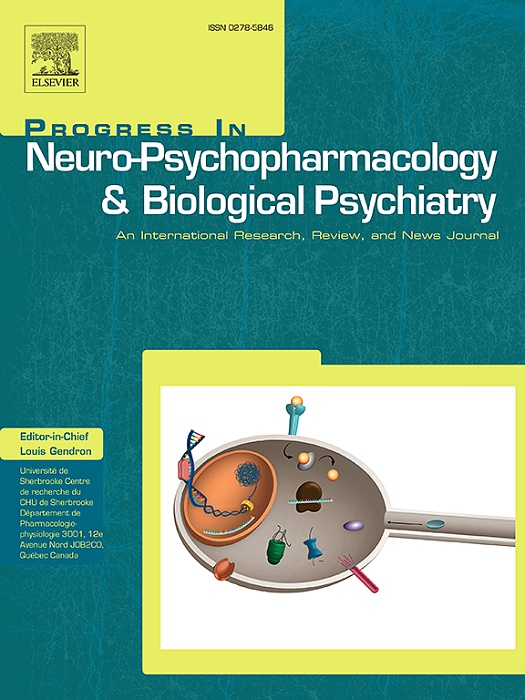Relationships between clinical symptoms, cognitive functioning, and TMS-evoked potential features in patients with major depressive disorder
IF 5.3
2区 医学
Q1 CLINICAL NEUROLOGY
Progress in Neuro-Psychopharmacology & Biological Psychiatry
Pub Date : 2024-11-15
DOI:10.1016/j.pnpbp.2024.111184
引用次数: 0
Abstract
Background
Cognitive impairment is a common clinical symptom of patients with major depressive disorder (MDD). Transcranial magnetic stimulation-evoked potentials (TEPs) detect cortical excitability and connectivity and provide potential biomarkers for MDD patients and their cognitive impairment. This study aimed to investigate the interrelationships between clinical symptoms, cognitive function, and electrophysiological marker TEPs in patients with MDD.
Methods
A total of 117 participants were recruited, including 59 MDD patients and 58 healthy controls. Clinical symptoms were assessed by the Hamilton Depression Rating Scale and Hamilton Anxiety Rating Scale, and cognitive functioning was assessed by the Repeatable Battery for the Assessment of Neuropsychological Status (RBANS). TEPs were recorded by transcranial magnetic stimulation combined with electroencephalography (TMS-EEG).
Results
MDD patients exhibited lower RBANS total (P < 0.001), immediate memory (P = 0.001), language (P = 0.003), attention (P < 0.001), and delayed memory (P = 0.008) scores than HCs. Patients with MDD had larger amplitudes for N100 (P = 0.040) and N280 (P = 0.037), compared to HCs. Correlation analysis indicated significant correlations between the following RBANS scores and TEPs: language and N45 amplitude (r = 0.222, P = 0.024), language and P60 amplitude (r = 0.278, P = 0.004), attention and P180 amplitude (r = 0.213, P = 0.030), RBANS total score and P30 amplitude (r = 0.198, P = 0.044), visuospatial/constructional index and N100 amplitude (r = −0.272, P = 0.005).
Conclusion
The results of this study indicate that cortical dysfunction and cognitive impairment are present in patients with MDD and that there is a strong correlation between them, suggesting that TEPs detected by the TMS-EEG may be used as a biomarker for MDD patients and their cognitive impairment.
重度抑郁症患者的临床症状、认知功能和 TMS 诱发电位特征之间的关系。
背景认知障碍是重度抑郁症(MDD)患者的常见临床症状。经颅磁刺激诱发电位(TEPs)可检测大脑皮层的兴奋性和连接性,并为 MDD 患者及其认知障碍提供潜在的生物标志物。本研究旨在探讨 MDD 患者的临床症状、认知功能和电生理标志物 TEPs 之间的相互关系:共招募了 117 名参与者,包括 59 名 MDD 患者和 58 名健康对照者。临床症状由汉密尔顿抑郁评定量表和汉密尔顿焦虑评定量表评估,认知功能由神经心理状态评估可重复电池(RBANS)评估。经颅磁刺激结合脑电图(TMS-EEG)记录了TEPs:结果:MDD 患者的 RBANS 总分(P)较低:本研究结果表明,MDD 患者存在大脑皮层功能障碍和认知障碍,且两者之间存在很强的相关性,这表明 TMS-EEG 检测到的 TEPs 可用作 MDD 患者及其认知障碍的生物标志物。
本文章由计算机程序翻译,如有差异,请以英文原文为准。
求助全文
约1分钟内获得全文
求助全文
来源期刊
CiteScore
12.00
自引率
1.80%
发文量
153
审稿时长
56 days
期刊介绍:
Progress in Neuro-Psychopharmacology & Biological Psychiatry is an international and multidisciplinary journal which aims to ensure the rapid publication of authoritative reviews and research papers dealing with experimental and clinical aspects of neuro-psychopharmacology and biological psychiatry. Issues of the journal are regularly devoted wholly in or in part to a topical subject.
Progress in Neuro-Psychopharmacology & Biological Psychiatry does not publish work on the actions of biological extracts unless the pharmacological active molecular substrate and/or specific receptor binding properties of the extract compounds are elucidated.

 求助内容:
求助内容: 应助结果提醒方式:
应助结果提醒方式:


